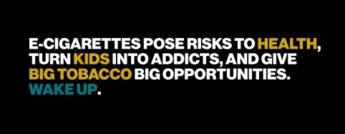FOR NICOTINE ENTHUSIASTS, 2015 will be remembered as part of a golden era. Less than 10 years after they were introduced in the United States, e-cigarettes have gone relatively unregulated by health agencies, with companies and users making their own rules in a nicotine-laced Wild West. E-cigarette companies have been advertising their products to adults and children alike, claiming to help smokers quit while simultaneously promoting lollipop-flavored liquids. But now health organizations, including the Centers for Disease Control and Prevention and even city-based public health departments are starting to fight back—not in the form of regulations, but with their own media campaigns.
It’s a tough fight to pick. Nationwide, more than 20 million people—about one in 10 adults—have tried e-cigarettes, and plenty of those people have become vaping devotees. That’s due at least in part to the way e-cig companies have advertised their products, unhindered by the FDA’s ad regulations for tobacco products. “It’s totally out of control,” says Stanton Glantz, director of the Center for Tobacco Control Research and Education at the University of California San Francisco. “For the first time since 1972, we have recreational nicotine being advertised on television and radio.” Reminiscent of glamorous smoking ads of the last century, many of the ads feature celebrity endorsements; in a Blu ad, Jenny McCarthy flirts with the camera while rejoicing that she can now smoke without scaring guys away with her smell. And many of them seem shockingly child-centric. “The youth use is exploding in parallel to the marketing,” says Glantz.
What’s a concerned public health agency to do? Fight ads with ads.
Still Blowing Smoke. And in January, the San Francisco Department of Health launched#CurbIt, pointing out the dangers of e-cigs and their brazen plays to hook kids while warning residents that vaping is only allowed in the same places as smoking.
There’s plenty of evidence behind the campaigns’ claims—studies that link e-cigs to asthma, lung inflammation, MRSA infection risk and exposure to harmful chemicals. But with scant data on the long-term health effects of e-cigarettes and their usefulness as a quitting tool, the ads use a number of classic psychological strategies to help beat back the ire of pro-vapers.
One CDC ad relies on anecdotal evidence to make its point. It features a story from an e-cigarette user, a 35-year-old wife and mother named Kristy from Tennessee who says she started smoking e-cigarettes hoping to quit combustible cigarettes. Instead, she began to smoke both, until her lung collapsed. The American Vaping Association reportedly called the ad “patently dishonest,” saying that it implies vaping led to lung disease, when in reality Kristy had gone back to smoking cigarettes alone in the months before her lung collapsed. California’s anti-vaping campaign lists toxins that humans once thought were safe—arsenic-laced powdered wigs, radium therapy, and of course cigarettes—and compares them to e-cigs, using a deceptive associative tactic that we’ve called out before.
The backlash against those campaigns has been swift. In the battle between public health and e-cigarettes, e-cigs have one major advantage: a massive population of users, many of whom credit the product with helping them to quit smoking, and who loudly defend their choice to vape. One thread on the American Vaping Association’s website collects anti-#CurbIt tweets. VaporVanity.com, a pro-vaping site, quickly posed the question: “Are The Members Of The San Francisco Health Department The Stupidest Human Beings On The Planet?” And pro-vapers launched a site nearly identical to California’s—called Not Blowing Smoke—that claimed that, well, basically everything the state said was a lie. The state’s Facebook post was quickly taken over by angry vaping fans. “There is this hyper-aggressive social media response to anyone who doesn’t think e-cigarettes are the greatest things ever,” says Glantz. “They’re trying to shut down any criticism.” Derek Smith of San Francisco’s Tobacco Free Project says his older colleagues saw similar reactions decades ago, when the city launched its first anti-smoking campaigns.
In a perfect world, the safety of a fun, potentially helpful smoking cessation method wouldn’t be left to nasty debates like this. The problem is, as in the early days of campaigns against cigarettes, there isn’t definitive evidence that e-cigarettes cause long-term harm—a point that pro-vapers will be quick to remind you of. But there also isn’t definitive evidence that they’re safe. And there are many good reasons to assume they’ll be found in time to increase cancer and heart and lung disease. “E-cig people would like you to believe that because the evidence that we have on them is limited, that we don’t know anything. And that’s just not true,” says Glantz. There’s a difference, he says, between not having evidence of an effect and having evidence of no effect.

SCREENSHOT: SAN FRANCISCO DEPARTMENT OF HEALTH
less toxic and carcinogenic than regular cigarettes. But that doesn’t mean that they’re not a health hazard. “We already know you’re breathing in a lot of toxic chemicals, which is bad,” says Glantz. “You’re breathing in a lot of toxic particles, which is bad. You’re taking in nicotine, which is bad. A cigarette is by far and away the most dangerous consumer product ever invented. So to say it’s not as bad as a cigarette is not saying very much.”
In the absence of incontrovertible evidence, then, public health agencies have to continue to play a little dirty themselves to get citizens to pay attention. In a couple of years, researchers will begin to do association studies to pull out long-term health effects. Until that science rolls in, the, prepare to sit back and enjoy the show. These two camps will be hashing it out for a while.
http://www.wired.com/2015/04/war-vapings-health-risks-getting-dirty/
It’s a tough fight to pick. Nationwide, more than 20 million people—about one in 10 adults—have tried e-cigarettes, and plenty of those people have become vaping devotees. That’s due at least in part to the way e-cig companies have advertised their products, unhindered by the FDA’s ad regulations for tobacco products. “It’s totally out of control,” says Stanton Glantz, director of the Center for Tobacco Control Research and Education at the University of California San Francisco. “For the first time since 1972, we have recreational nicotine being advertised on television and radio.” Reminiscent of glamorous smoking ads of the last century, many of the ads feature celebrity endorsements; in a Blu ad, Jenny McCarthy flirts with the camera while rejoicing that she can now smoke without scaring guys away with her smell. And many of them seem shockingly child-centric. “The youth use is exploding in parallel to the marketing,” says Glantz.
What’s a concerned public health agency to do? Fight ads with ads.
Still Blowing Smoke. And in January, the San Francisco Department of Health launched#CurbIt, pointing out the dangers of e-cigs and their brazen plays to hook kids while warning residents that vaping is only allowed in the same places as smoking.
There’s plenty of evidence behind the campaigns’ claims—studies that link e-cigs to asthma, lung inflammation, MRSA infection risk and exposure to harmful chemicals. But with scant data on the long-term health effects of e-cigarettes and their usefulness as a quitting tool, the ads use a number of classic psychological strategies to help beat back the ire of pro-vapers.
One CDC ad relies on anecdotal evidence to make its point. It features a story from an e-cigarette user, a 35-year-old wife and mother named Kristy from Tennessee who says she started smoking e-cigarettes hoping to quit combustible cigarettes. Instead, she began to smoke both, until her lung collapsed. The American Vaping Association reportedly called the ad “patently dishonest,” saying that it implies vaping led to lung disease, when in reality Kristy had gone back to smoking cigarettes alone in the months before her lung collapsed. California’s anti-vaping campaign lists toxins that humans once thought were safe—arsenic-laced powdered wigs, radium therapy, and of course cigarettes—and compares them to e-cigs, using a deceptive associative tactic that we’ve called out before.
The backlash against those campaigns has been swift. In the battle between public health and e-cigarettes, e-cigs have one major advantage: a massive population of users, many of whom credit the product with helping them to quit smoking, and who loudly defend their choice to vape. One thread on the American Vaping Association’s website collects anti-#CurbIt tweets. VaporVanity.com, a pro-vaping site, quickly posed the question: “Are The Members Of The San Francisco Health Department The Stupidest Human Beings On The Planet?” And pro-vapers launched a site nearly identical to California’s—called Not Blowing Smoke—that claimed that, well, basically everything the state said was a lie. The state’s Facebook post was quickly taken over by angry vaping fans. “There is this hyper-aggressive social media response to anyone who doesn’t think e-cigarettes are the greatest things ever,” says Glantz. “They’re trying to shut down any criticism.” Derek Smith of San Francisco’s Tobacco Free Project says his older colleagues saw similar reactions decades ago, when the city launched its first anti-smoking campaigns.
In a perfect world, the safety of a fun, potentially helpful smoking cessation method wouldn’t be left to nasty debates like this. The problem is, as in the early days of campaigns against cigarettes, there isn’t definitive evidence that e-cigarettes cause long-term harm—a point that pro-vapers will be quick to remind you of. But there also isn’t definitive evidence that they’re safe. And there are many good reasons to assume they’ll be found in time to increase cancer and heart and lung disease. “E-cig people would like you to believe that because the evidence that we have on them is limited, that we don’t know anything. And that’s just not true,” says Glantz. There’s a difference, he says, between not having evidence of an effect and having evidence of no effect.

SCREENSHOT: SAN FRANCISCO DEPARTMENT OF HEALTH
less toxic and carcinogenic than regular cigarettes. But that doesn’t mean that they’re not a health hazard. “We already know you’re breathing in a lot of toxic chemicals, which is bad,” says Glantz. “You’re breathing in a lot of toxic particles, which is bad. You’re taking in nicotine, which is bad. A cigarette is by far and away the most dangerous consumer product ever invented. So to say it’s not as bad as a cigarette is not saying very much.”
In the absence of incontrovertible evidence, then, public health agencies have to continue to play a little dirty themselves to get citizens to pay attention. In a couple of years, researchers will begin to do association studies to pull out long-term health effects. Until that science rolls in, the, prepare to sit back and enjoy the show. These two camps will be hashing it out for a while.
http://www.wired.com/2015/04/war-vapings-health-risks-getting-dirty/





